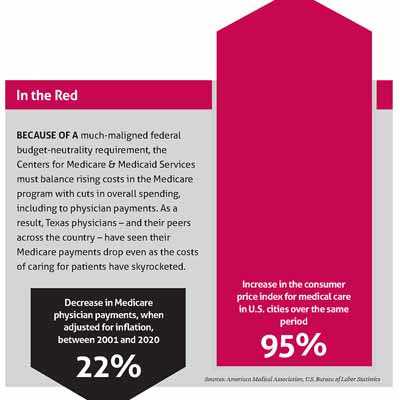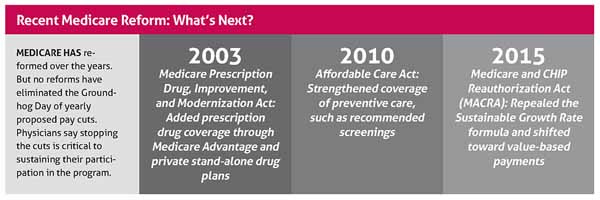And imagine your company did that after not giving you a cost-of-living raise for more than two decades.
Unfortunately, physicians don’t have to imagine that scenario, which Texas Medical Association President E. Linda Villarreal, MD, described late last year as Congress threatened a nearly 10% cut to physicians’ Medicare payments on top of doctors’ emotional and financial struggles with another surge in the COVID-19 pandemic.
Fortunately, lawmakers listened as TMA and others in organized medicine mobilized to stop the cuts. Thanks to that advocacy, Congress eliminated most of the proposed reductions. In doing so, federal lawmakers protected seniors’ access to care and saved physician practices from serious consequences, such as tapping into lines of credit to meet payroll.
But physicians know all too well this relief is temporary.
Nearly every year, organized medicine fights back against statutorily required Medicare physician pay cuts, which stem in part from a federal budget neutrality provision that requires any physician pay increase or decrease to be offsetting.
This rigmarole is even more taxing during the ongoing pandemic, when practices face myriad financial and emotional stressors. “Physicians need support right now – not a pay cut,” said Dr. Villarreal, an internist in Edinburg.
TMA leaders say the only way to prevent this scenario from repeating itself ad infinitum is to enact comprehensive Medicare reform that addresses the budget-neutrality provision and adjusts the physician payment formula to keep pace with inflation. But they also are aware of the obstacles that stand in their way.
“This pattern of 11th hour – or even 12th hour – Band-Aids on the program continues because there isn’t an easy fix,” said Rodney Young, MD, a family physician in Amarillo and chair of TMA’s Council on Socioeconomics.
Insult upon injury
When the Centers for Medicare & Medicaid Services (CMS) released its 2022 Medicare Physician Fee Schedule proposal last summer, TMA immediately raised concerns. As initially conceived, the cuts would have totaled nearly 10%, including:
- A 3.75% reduction to the 2022 Medicare Physician Fee Schedule conversion factor, a multiplier that’s part of the calculations for payment rates for a particular service;
- A 2% across-the-board cut known as sequestration, which Congress has delayed several times before and during and the pandemic; and
- An additional 4% sequestration cut resulting from the American Rescue Plan Act, the price tag of which surpassed a threshold in federal law meant to rein in deficit spending.
President Joe Biden signed the Protecting Medicare and American Farmers from Sequester Cuts Act into law on Dec. 10, 2021, which instituted an overall .75% physician pay cut on Jan. 1. Under the bill, the 2% sequestration cut is eliminated until the beginning of April, when a 1% cut will take effect for three months. The oft-delayed 2% cut will take effect in July, bringing the total reduction to 2.75%, unless Congress intervenes again.
“Physicians will still face a slight cut in 2022, with no permanent solution to avoid future cuts,” Dr. Villarreal said. “What’s really needed is a more meaningful, permanent policy for how Medicare pays physicians, so Congress doesn’t have to revisit this issue.”
Over the past 20 years, Medicare physician payments have decreased by nearly a quarter, when adjusted for inflation, according to the American Medical Association. At the same time, the costs of providing care and of running a practice have increased dramatically. (See “In the Red,” page 34.)
This equation forces physicians to make hard decisions, such as limiting the number of Medicare patients they see, just to keep their doors open.
“The payments in and of themselves are not sufficient to cover the overhead of a practice,” Dr. Young said.
Add to that the pandemic pressures that already had forced practices to dip into their personal savings and capital, and many physicians would have reached the brink: Nearly two-thirds of Texas physicians reported they might have been forced to stop seeing new Medicare patients had the cuts been implemented, according to an October survey of nearly 1,400 TMA members. Additionally, nearly 60% of respondents said they would have considered opting out of Medicare entirely, and 43% said they might have considered retiring.
When physician practices stop accepting new Medicare patients or close altogether, medically vulnerable patients are displaced, says Dr. Young. Some find care at safety-net health systems, but this spillover demand drives up appointment wait times and strains already-limited resources. Others fall through the cracks.
“From a patient perspective, that’s very, very disruptive,” he added.

A permanent fix
TMA through its federal advocacy continues to push for a permanent solution to this recurring problem. Texas physicians have some ideas about what it should look like.
Perhaps the most oft-cited solution: Repeal the budget-neutrality provision.
“What else works in America that’s a zero-sum game?” asked TMA President-Elect Gary Floyd, MD. He added “wholesale physician payment reform” is a top priority for TMA that he puts in the “‘has-to-happen’ [category], or we’re going to see many more physicians opt out of taking care of [Medicare] patients. And that will put a strain on not only access but also physicians finding other business that will pay them enough to keep their offices open.”
Federal lawmakers are aware of these problems and have raised their own concerns. In a Sept. 13, 2021, letter to CMS Deputy Administrator and Director Meena Seshamani, MD, 75 members of Congress – including U.S. Rep. Michael Burgess, MD (R-Lewisville), the senior physician representing Texas in Congress – called for “fundamental [physician fee schedule] reform.” They cited the “budget-neutrality provision” as the primary driver of drastic cuts to physicians and other health care professionals.
Another answer: Tie Medicare physician payments to a metric such as the consumer price index or the cost of living, both of which would help prevent rates from stagnating or declining, says Luis Benavides, MD, a family physician in Laredo and a member of TMA’s Council on Socioeconomics.
“Our cost of business is going up every year, and we’re not getting meaningful raises,” he said. “On top of that, there’s the anxiety at the end of the year: Are we going to get paid [at all]?”
Other possibilities: Dr. Young, the Amarillo family physician, says other players in the health care system, including hospitals and drug manufacturers, receive Medicare payments that are commensurate with, or even exceed, the costs of providing services. Long overdue physician pay raises could be offset by evening out these arrangements.
“The Medicare budget can’t be balanced on the backs of physicians alone,” he said.

Tex Med. 2022;118(2):32-34
March 2022 Texas Medicine Contents
Texas Medicine Main Page